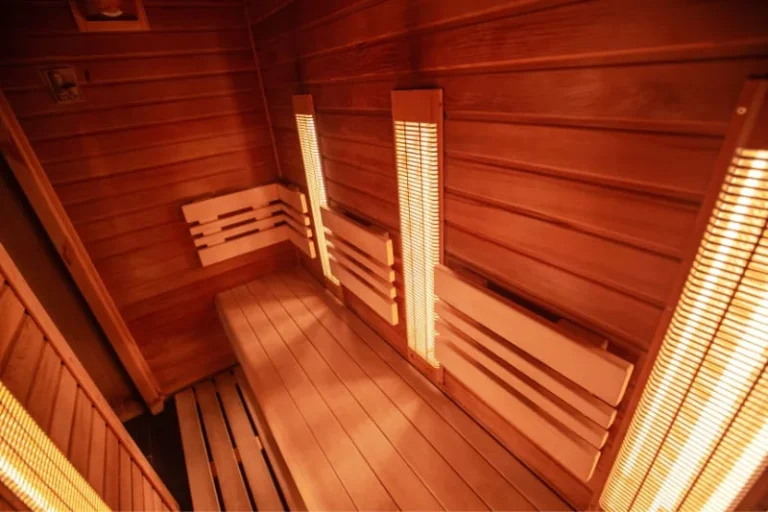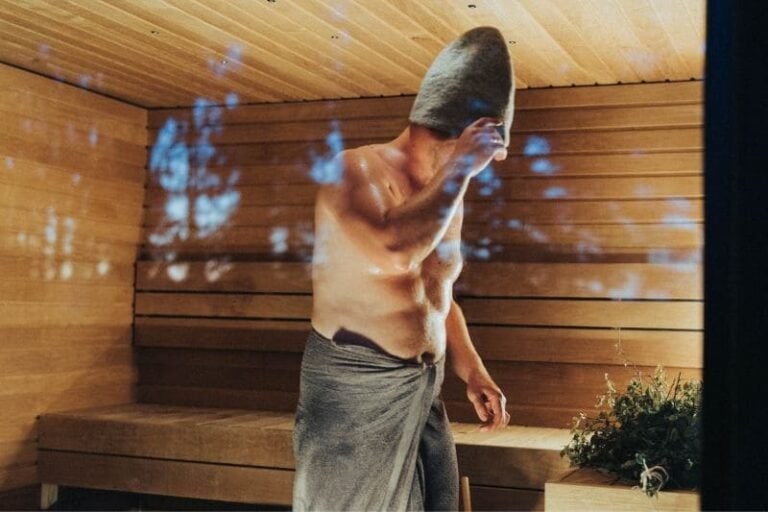How to Stain a Sauna: Expert Tips for a Perfect Finish

Proper staining can add two decades to your sauna’s life!
Key Takeaways
- Select appropriate stains based on indoor/outdoor sauna location
- Clean and prepare surfaces properly before staining
- Apply stain using the correct techniques and tools
- Allow proper drying time between coats
- Regular maintenance extends stain life
Creating a well-maintained sauna starts with proper staining. Learning how to stain a sauna correctly can seem overwhelming, but I’ve helped countless sauna owners protect their investments, and I’m excited to share exactly what works.
Table of Contents
Choosing the Right Stain
Choosing the right stain for your sauna goes beyond color – you need protection and longevity. The location of your sauna plays a huge role in this decision.
Types of Stains for Different Sauna Locations
For outdoor saunas, I always recommend oil-based stains. These stains sink deep into the wood fibers, creating a strong barrier against nature’s elements. They excel at blocking UV rays and keeping moisture at bay, which makes them perfect for your outdoor sauna experience.
🔍 Pro Tip: In high-humidity areas, mix 2 parts stain with 1 part wood preservative for better moisture resistance in your sauna. I learned this trick after fixing a few water-damaged saunas in Florida.
Related: DIY Outdoor Sauna
Indoor saunas need a different approach. Water-based sealers are your best choice here. They’re non-toxic and food-grade, making them safe for the high heat and moisture of your sauna room. I’ve seen fantastic results with these sealers in countless indoor installations.
Related: DIY Indoor Sauna
Color and Finish Options
- Natural stains preserve wood’s beauty
- Pigmented stains cover imperfections
- Clear stains highlight wood grain
- Solid stains offer maximum protection
🔍 Pro Tip: Always test your chosen stain on a small, hidden area first!
How to Stain a Sauna: Preparation Steps
- Gather Your Materials
- Quality brushes
- Protective gear
- Clean rags
- Deck-stain applicator
- Drop cloths
- Mild soap solution
- Sandpaper
- Clean the Surface
- Mix a mild soap solution with warm water.
- Scrub the entire sauna surface thoroughly to remove all dirt, grime, and debris.
- Pay special attention to any areas with blue-stain fungi.
- Once cleaned, rinse the wood completely with clean water and allow it to dry fully.
- Inspect and Repair
- Walk around your sauna and examine every section carefully.
- Fix any loose boards, repair damaged areas, and address any moisture issues you find.
- If there’s an old stain peeling off, remove it completely before proceeding.
- Sand the Wood
- Take your medium-grit sandpaper and sand the entire surface in the direction of the wood grain.
- This opens up the wood pores for better stain absorption and creates a smooth finish.
- After sanding, remove all dust with a clean cloth.
- Final Preparation
- Cover all surrounding areas with drop cloths to protect them from stain splatter.
- Create proper ventilation by opening windows or setting up fans.
- For outdoor saunas, check the weather forecast to ensure ideal conditions.
- Before starting the main application, test your chosen stain on a small, hidden area to confirm the color and absorption.

How to Stain a Sauna: Application Process
The staining process demands precision and patience.
- Start early in the day, especially for outdoor saunas, to maximize daylight hours.
- Put on your protective gear and ensure proper ventilation before beginning.
- Pour your stain into a wide container for easy brush access.
- Always stir the stain – never shake it, as this creates bubbles that can ruin your finish.
- Start at the top of each wall and work your way down.
- Apply the stain using long, even strokes that follow the wood grain. This technique prevents lap marks and ensures even coverage.
- Maintain a wet edge by working in small sections and never stop halfway through a board.
🔍 Pro Tip: I always keep a “wet edge” by staining only 2-3 boards width at a time. When I rushed this once, it left visible lap marks that needed complete refinishing.
Temperature and Timing Considerations
The ideal temperature range for staining sits between 50-90°F. Beyond these limits, your stain might not adhere properly. For outdoor saunas, pick a day with low humidity and no rain in the forecast for 48 hours.
After the first coat, wait 24-48 hours before deciding if you need a second coat. The wood’s absorption rate will tell you – if it looks patchy or uneven, apply another coat.
Special Considerations
Indoor vs Outdoor Differences
Indoor saunas face different challenges than their outdoor counterparts.
For indoor saunas, focus on:
- Heat resistance
- Moisture protection
- Non-toxic finishes
- Proper ventilation during application
For outdoor saunas, prioritize:
- UV protection
- Weather resistance
- Deep wood penetration
- Extra protection for exposed areas
Wood Type Specifics
Different woods need different approaches.
- Cedar barrel saunas require lighter coats due to their natural oils.
- Pine needs extra protection against moisture.
Match your staining technique to the type of wood you have.
Key Safety Rules
- Never rush the drying process by heating your sauna.
- Keep air flowing through the space during application and drying.
- Most importantly, wait at least 72 hours after staining before using your sauna for the first time.
Maintenance and Care
Your sauna’s new stain needs regular attention to stay vibrant and protective. I recommend checking the finish every six months. Look for wear spots, especially on the most-used areas like benches and door frames.

Here’s your basic care schedule:
- Weekly Cleaning: Wipe surfaces with a soft, damp cloth. Stay away from harsh chemicals – plain water works great for regular cleaning.
- Monthly Deep Clean: Mix a mild soap with warm water. Clean every surface, then dry with a soft towel. This stops any moisture buildup that might harm your stain.
- Twice-Yearly Inspection: Run your hands over every surface. Feel for rough spots or areas where the stain looks thin. Mark these spots – they’ll need touch-ups soon.
Touch-up Tips
Spot-fixing beats a complete re-stain.
- Sand the worn area lightly.
- Apply your stain with a small brush or cloth.
- Blend the edges into the existing finish.
- Let it dry for 48 hours.
Related: How to Clean Sauna Wood
Understanding Staining Costs
Let’s talk money – what will staining your sauna actually cost? Here’s what I’ve seen work best for different budgets:
Stain Options and Coverage
Oil-based stains run $35-$120 per gallon, while water-based options cost $20-$80. Both cover about 200-300 square feet per gallon. Natural stains fall somewhere in between at $20-$100 per gallon.
DIY vs Professional Route
Taking the DIY path? For a typical 500 sq ft sauna, expect to spend $200-$600 on materials. Going professional adds labor costs of $1-$3 per square foot, bringing your total to $700-$2,100.
🔍 Pro Tip: While oil-based stains cost more upfront, they typically last 2-3 years before needing reapplication. Water-based options might need yearly touch-ups, making them potentially more expensive long-term.
Troubleshooting Common Staining Problems
Even with careful preparation, you might encounter some challenges while staining your sauna. Here are quick fixes for the most common issues:
Why is my stain feeling sticky?
If the stain feels sticky after the recommended drying time, excess stain or high humidity is likely the culprit. Run a fan to boost air circulation and wipe off any excess stains promptly.
Why is my stain looking uneven?
Spot uneven staining? Wood density variations or natural oils often cause this. Sand affected areas lightly and apply a gel stain. For oily woods like cedar, clean with mineral spirits first, then use a pre-stain wood conditioner.
How do I fix common staining issues?
- Dark patches? Lightly sand and apply thinner coats.
- Peeling spots? Remove loose stain, sand smooth, then reapply.
- Water spots? Sand affected area and recoat once completely dry.
🔍 Pro Tip: If color transfers to your hand after the recommended drying time, you’ll need to wipe the surface with mineral spirits and allow extra drying time.
Conclusion
A stained sauna gives you years of relaxation and wellness. From barrel saunas to indoor havens, the right stain makes all the difference. Remember these key points for success:
- Pick stains made for sauna use
- Take time with preparation
- Apply evenly and patiently
- Check your work regularly
- Fix small issues fast
Your backyard sauna experience starts with great staining. With these steps and tips, you’re ready to create a sauna that looks amazing and lasts for decades.

As a Chartered Accountant turned sauna enthusiast, I bring a unique blend of analytical skills and hands-on experience to the world of heat therapy. With over a decade dedicated to researching and testing sauna products and practices, I’ve developed a deep understanding of this field. A the founder of HomeInDepth.com, I provide reliable, easy-to-understand information on all aspects of saunas. My goal is to guide you through every step of your sauna journey, offering meticulously researched, unbiased advice to help you make informed decisions and create your perfect sauna experience. I’m always happy to hear from sauna lovers like you—feel free to leave questions or share your own tips in the comments below so we can learn together. Contact me on:








One Comment